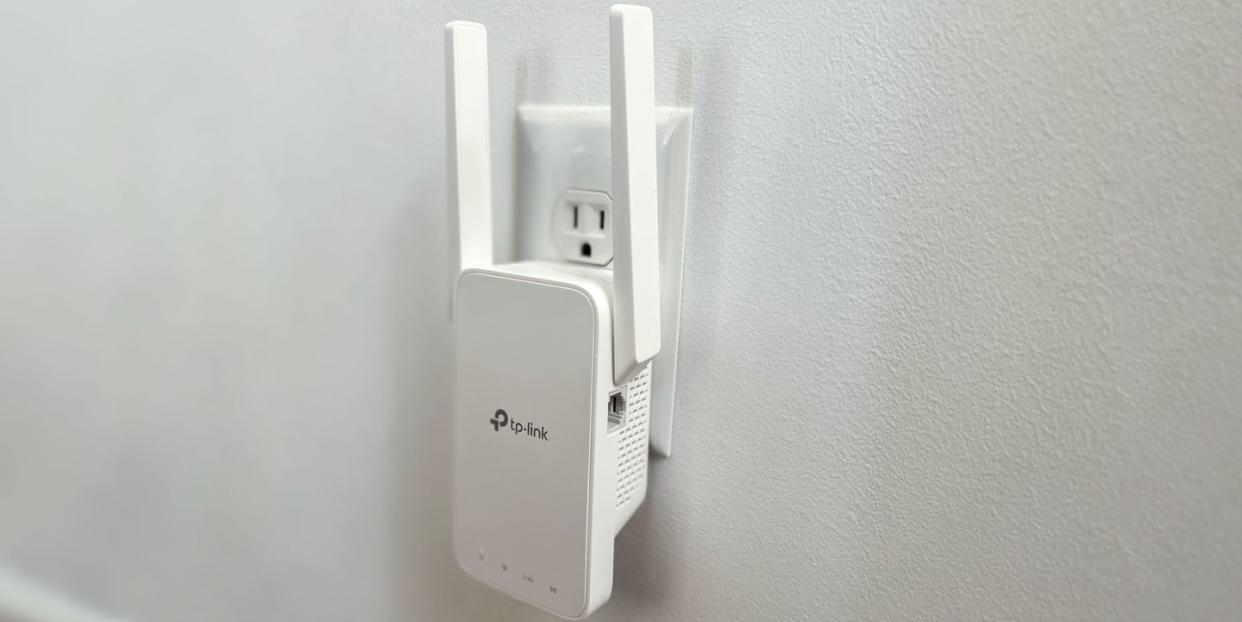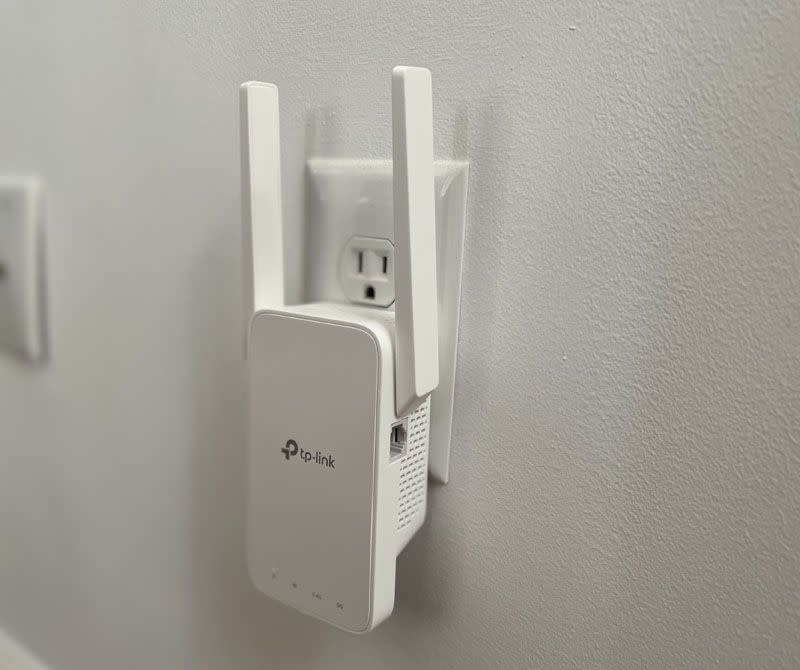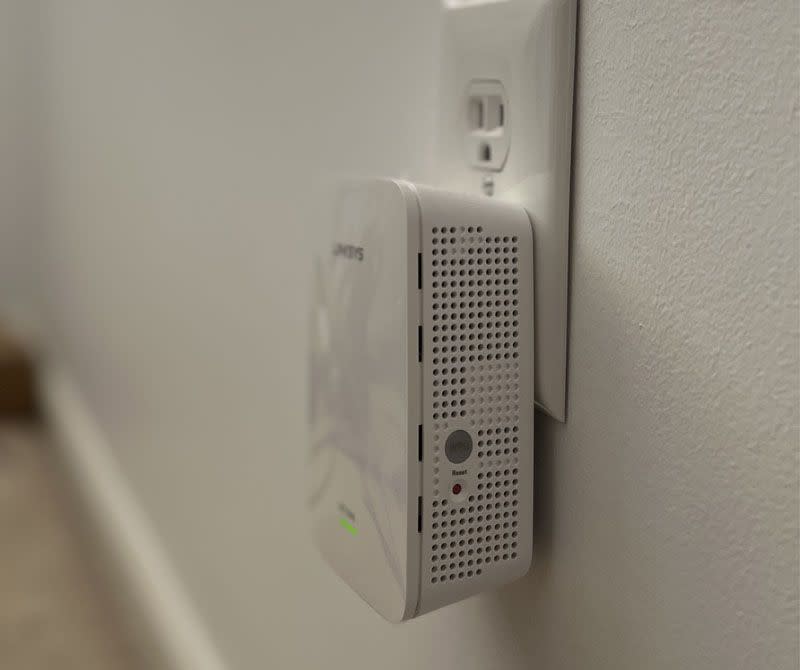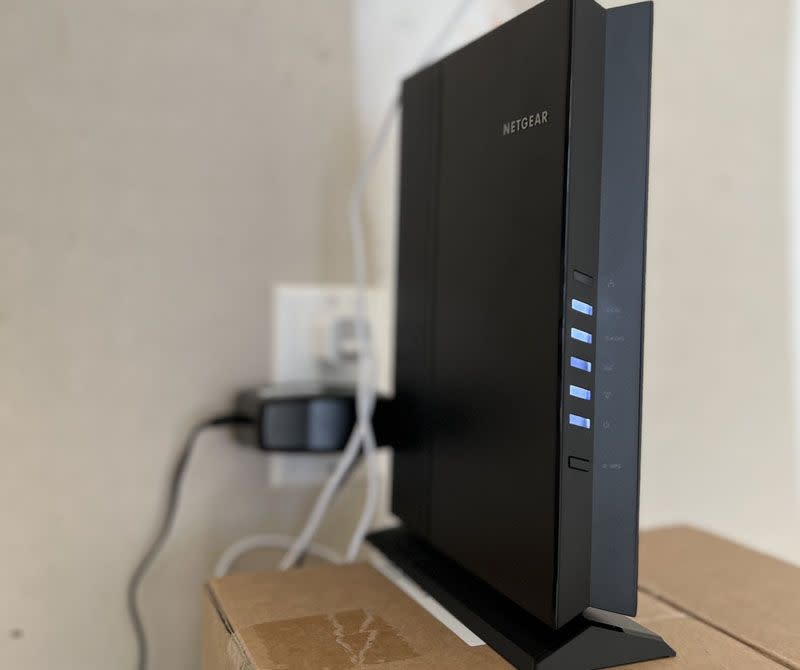The Best Wi-Fi Extenders for Fast Home Internet

"Hearst Magazines and Yahoo may earn commission or revenue on some items through the links below."
Home Wi-Fi networks powered by a single router can sometimes struggle to provide complete internet coverage depending on your space’s layout and construction. Add in the interference of nearby networks or other household devices, and it’s easy to see how signals can get lost or blocked entirely. A Wi-Fi extender is a compact plug-in device that works by repeating a router’s signals to hard-to-reach Wi-Fi dead zones—such as an upstairs office in a far corner of a house or a loft in a multi-story apartment.
If you’re working from home, that means you can move your workspace farther away from high-traffic areas in your house. And in non-central spaces like bedrooms or the basement, an extender can boost download speeds so your devices can stream movies and play online games without buffering.
Check out quick info below on the top five Wi-Fi extenders and mesh systems, then keep scrolling for helpful buying info and full reviews of these models and other high-ranking options.
How to Tell if You Need an Extender or Just a New Router
If you experience lagging internet speeds, it can be difficult to determine whether your entire router needs to be replaced or if you can just opt for an extender. Check to see if your connection works fine while close to the router but drops off in certain areas like the basement, upstairs, or patio. A cheap extender is likely all you need to resolve this. Simply place an extender somewhere where it can reach the router’s signal, so that it can then rebroadcast it to cover more area. While cost efficient, this isn’t the most seamless option as extenders create their own network, aren’t as fast as your typical router, and eat up twice as much channel bandwidth.
If you find that your internet speed is subpar everywhere in your home, it may be worth revamping your entire system. In these cases, we recommend going with a mesh Wi-Fi system, which can replace your router and any extenders by placing compact nodes around your home to create more seamless coverage without any separate networks. As mesh systems become more popular, they’re becoming more affordable too—though new systems will still cost much more than the average extender. In addition to the six standard extenders we recommend here, we’ve also included three mesh systems at the bottom of this roundup that we’ve tested and recommend.
The Differences Between Extenders
Wi-Fi extenders can vary considerably in features and capabilities. The majority support 2.4-GHz and 5-GHz frequency bands and are known as dual-band devices, but some cheaper options are only single-band and use 2.4-GHz frequency to transmit data. Typically, dual-band extenders provide a faster connection because they have more bandwidth and experience less interference, which makes them a better choice for gaming and video streaming. However, single-band extenders have a farther range that can provide better coverage in spaces with many obstacles, such as walls and furniture. Higher-end tri-band extenders, which feature two 5-GHz bands and one 2.4-GHz band, cost more but give you the best coverage with the least interference.
By the same token, you can also generally expect to pay more for extenders with more antennas, which you might or might not need depending on the size of your house or apartment. Antennas can be external or internal, and the more a device has, the better it’s able to pick up and transmit Wi-Fi signals.
Like routers, extenders are rated in different classes, such as AC1200 and AC1750, where the number simply indicates the combined maximum speeds they are capable of supporting (measured in megabits per second, or Mbps). They come in a range of different shapes and sizes, from small plug-in units that will largely go unnoticed to bulky, desktop-style units you’ll need to clear some space for.
How We Tested and Selected
To choose these Wi-Fi extenders, we surveyed the market, evaluated models based on coverage, speed, cost, and design, and tested the most promising ourselves. We ran each extender on a home network with internet speeds of 500 Mbps for downloads and 25 Mbps for uploads. Each extender was plugged into the same socket on power outlets spanning three different floors of a 2,000-square-foot townhouse.
The first outlet sat just five feet away from the router on the same floor, the second 25 feet from the router on a floor just below it, and the last in a garage 50 feet from the router separated by two floors and concrete. We used Ookla’s speed test to record the speeds of each extender from the same marked point on each floor. We compared the results to those of the router on its own for a control in addition to others in the pool to rank speed performance. To test for range, we connected the extender to the garage outlet, which is on the outskirts of our network, then walked in a straight line with a measuring wheel until we no longer received a Wi-Fi signal.
For the extenders we weren’t able to get hands on, we relied on expert sources including Tech Radar, CNET, and PC Mag, as well as customer reviews from various retailers like Amazon, Best Buy, and Walmart. You’ll find the reviews of these three untested but recommended picks just below the “Other Great Options” section.
—BEST VALUE—
TP-Link RE315 AC1200
TP-Link’s RE315 is a powerhouse for just $30. Its boxy body is equivalent in size to the standard iPhone and plugs into the bottom socket of a power outlet, leaving the top input open. With an antenna on each side of the extender creating a rabbit-ear-like appearance, these bands offer speed and range performance that keeps up with extenders triple the price. After we plugged the unit into an electrical outlet and connected it to the Wi-Fi network, the cloud-based TP-Link app made it easy to configure the extender to our network’s 2.4- and 5-GHz bands. From the app, you can easily manage the extender and access helpful features like Wi-Fi password sharing.
During our testing, the RE315 maintained a download speed of 250 Mbps 5 feet from the router, half of our control router’s actual speed of 499 Mbps. Plugged into an outlet one floor below the router and 15 feet to the right side, the extender put out 205 Mbps. And on the ground floor garage separated by an additional layer of sub flooring and concrete, the extender produced 171 Mbps. That’s especially impressive because those speeds meant we could take Zoom calls from our driveway and watch live Twitch streams without a hiccup. Beyond our front yard we were able to walk exactly 120 feet from the extender before losing a signal. At the absolute fringes of coverage, this extender sent out download speeds of 15 Mbps, which is still plenty for smoothly streaming HD video.

This is our top choice overall because it’s affordable, easy to use, and offers as much speed as some of the best options available. For simply extending your Wi-Fi network to cover a dead zone, the RE315 delivers comprehensive coverage. It’s not the best looking Wi-Fi extender in the bunch, but we spring for functionality over form any day. While the device is universally compatible with any router, it can also function as part of a seamless mesh system when paired with the Archer A7 router using TP-Link’s OneMesh setup.
—SLEEK DESIGN—
Linksys Max-Stream RE7000 AC1900
Wi-Fi extenders don’t get much more minimalist than this model from Linksys. The RE7000 ditches external antennas for an inconspicuous rectangular design that plugs directly into the wall. It features a single LED status light on the front and plenty of ventilation around the body that affords internal components some breathing room. This modern styling makes for a great choice if your only placement option is somewhere particularly visible in your home.
Despite its compact size, it doesn’t sacrifice any features—including internal dual-band AC1900 speeds, a gigabit ethernet port, and a button for syncing with WPS-equipped routers in a single push. While setup over a browser wasn’t as smooth as rivals (taking three attempts to extend both bands of our control router), the extender boosts signals anywhere within range of your Wi-Fi. From 5 feet away and on the same floor as our control router, we received a respectable 203 Mbps. On the ground floor below, we saw 175 Mbps, and in the garage, 138 Mbps. The speeds are slightly hampered due to the lack of external antennas, and its range is a bit shorter with the signal cutting out at 75 feet away.

With that said, the RE700 is a stylish mid-range option. It beats out the speed performance of comparable models we tested, boasts a space-saving design, and offers an unwavering connection within its range—perfect if you need to add Wi-Fi to a dead zone within your home. However if you want to boost a signal in your back or front yard, this isn’t the best option, as you can’t direct the signal using antennas and its range is tighter.
—BEST PERFORMANCE—
Netgear Nighthawk EAX20 AX1800
The Nighthawk’s huge size may rival that of your router itself, but it holds two internal Wi-Fi 6 antennas, providing a strong signal and mesh-like blanket of coverage. The EAX20 had no impact on the speed of our control router and combined its Wi-Fi coverage under one network name. This meant that as we moved rooms or out of range of the control router, our devices automatically switched to the Nighthawk instead of requiring us to connect to a separate “EXT” Wi-Fi network like those created by other extenders. Plus, its four ethernet ports allow for multiple devices to hook up to the wired connection.
There’s no browser or address to worry about for setup. You simply plug the extender in and download the Netgear Nighthawk app to your phone. The app discovers the device automatically—you just need to connect it to your network. Once connected, the Nighthawk will update automatically, sending you to extender’s main menu. From here you can manage devices, test your speeds, and adjust Wi-Fi settings easily.
While its bulky tower design allows for more powerful internals, it requires a separate power adapter—not as convenient as all-in-one wall plug units like the two options above. This can especially be a pain if you plan on plugging it into an elevated power outlet like those found in the kitchen or a garage. Our tester used a tall cardboard box to raise the extender to match the position of the plug-in extenders for testing purposes, but in a long-term scenario you’ll want to place the tower on some sort of support. Spending the time to find the optimal placement provided us with the best speed and range performance in our pool.

In our speed tests, the extender put out a blazing 303 Mbps 5 feet from the router, 289 Mbps 25 feet from the router on the floor below, and 270 Mbps two floors directly below the router. Not only is this extremely fast for a repeater, the signal performance received a boost as we walked farther away in our line-of-sight test thanks to beam-forming technology that strengthens signal to high bandwidth devices that are farther away. At 75 feet away, we received an unbelievable average of 290 Mbps—even after running the speed test twice. And after we walked up the stairs of an adjacent building in our complex, the signals made their way through walls and up a staircase to deliver 190 Mbps of download speed from 175 feet away—nearly the other side of the apartment building. If you want the most strength and range, this is the best option under $100. But you’ll need the space for it.
OTHER GREAT OPTIONS
—SIMPLE SETUP—
D-Link DAP-X1870 AX1800
Simply plug the DAP-X1870 into an electrical outlet in range of your Wi-Fi network, hit a single WPS button, and you’re all set. Instead of creating an extended network, this extender uses the name of your existing Wi-Fi, like the Nighthawk above. It even supports the latest Wi-Fi 6 standard for better bandwidth distribution across connected devices. This mesh-like setup means your devices automatically switches to the extender when needed. Its basic app lets you monitor your network traffic to see what—or who—might be slowing down your signal. If you need more than just a boost in a distant room and are willing to pay for it, the D-Link DAP X-1870 easily adds powerful AX1800 speeds over four different channel to your home within seconds.
—FOR GAMING—
Netgear EX6200 AC1200
Ideal for video streaming or gaming, the Netgear EX6200 will match your gaming computer with its large but sleek and aggressive design. The dual-band extender features four antennas for powerful coverage with speeds up to 1,200 Mbps, ideal for stable, lag-free coverage in your online games. Beyond your consoles, there’s enough bandwidth to provide blazing fast speeds to a few more devices in a remote room or backyard. The EX6200 also has an impressive total of five ethernet ports for when you need wired connection for devices like a gaming computer, smart TV, or printer.
—POWERFUL PLUG-IN—
TP-Link RE650 AC2600
Though it’s bulkier and pricier than many other plug-in extenders, many reviewers such as PC Gamer and Tom’s Guide praise TP-Link’s RE650 for top-tier performance and a wide range of features. It has four antennas for maximizing coverage around your property while providing fast AC2600 speeds to multiple devices simultaneously. For wired devices, there’s a gigabit ethernet port. Plus, it has a smart light indicator that helps you find the perfect placement if you’re unsure of the right area to put your extender. It’s unsightly and takes up an entire electrical outlet by itself, limiting placement options, but it’s one of the fastest wall plug extenders on the market.
Mesh Wi-Fi Systems
Eero Pro + 2 Beacons
The Eero Pro is dead easy to set up: Simply connect it to a modem through the smartphone app and follow the app’s instructions. There’s no need for networking smarts, but know that the Eero Pro is a tri-band Wi-Fi network, meaning there’s just one network that connects devices at the speed they require. In a 2,900-square-foot stone house with two-foot-thick walls, we never had an issue with signal strength inside, but connecting on the patio or adjacent outbuilding has been problematic. After installing the Eero with one beacon near a window and another in the outbuilding, we had almost two acres of property covered, including a barn another 100 feet away.
This expansive coverage was impressive enough, but the power to manage the network through the app is another bonus. The app shows all connected devices and their status, so you’ll know if your kid is streaming Netflix or doing homework. If that’s a regular issue, you can even set schedules for certain devices to access the internet. While the Eero Pro with two beacons claims to cover a 5,500-square-foot home, if you don’t need nearly that much square footage covered, the standard Eero router for 1,500 square feet is a good alternative for much less.
Google Nest Wi-Fi Router + Point
Google’s Nest Wi-Fi is an appealing mesh alternative, which forms a complete system instead of secondary networks. Each hub, which Google refers to as points, doubles as a Google Assistant-powered speaker that can stream music or podcasts, control connected devices, and do a lot of other voice-enabled skills. If you’re already living in Google’s smart home ecosystem, you won’t find a better Wi-Fi option. Setup in the Google Home app is remarkably easy; it took us less than 10 minutes from unboxing to surfing on our new network.
Performance is great, too. Google says one router and point covers up to 3,000 square feet, which proved accurate in our testing, delivering very fast internet download speeds to areas of our test home that were out of reach with a single router. Our speed test showed download rates of 201.6 mbps a foot away from the router, 195.2 next to the upstairs hub, and 161.8 in a distant upstairs bedroom, about 45 feet away from the hub. Speeds dropped to 81.5 mbps at the point in the house farthest from a router or hub (about 70 feet), but that’s still fast enough for streaming movies and Zoom video conferences.
Netgear Orbi Voice RBK50V
The whole Netgear Orbi RBK50V system claims to cover an impressive 4,500-square-foot area with one Orbi router and a satellite that also functions as a smart speaker with built-in Alexa. If you already have a router and just want to add the satellite as a two-in-one extender and smart speaker, it’s rated to cover an additional 2,000 square feet with speeds up to 2.2 Gbps. If you already have or don’t want a speaker, Netgear also offers Orbi satellites in desktop, wall-plug, or outdoor tabletop versions depending on your needs.
In our testing, this tri-band mesh system provided consistent, if not faster, internet. We’ve been able to connect an Amazon Fire TV directly to the network and stream Netflix, Amazon Prime, and HBO Max without any lagging or buffering. When downloading some large 30+ GB files to a Playstation, its download speed wasn’t particularly quick, but it was steady, whereas in the past, the router would struggle with the files and cause long pauses during downloading. While the system is easy to manage, we felt like the initial setup instructions could have been clearer. For instance, it explains what cord to plug into the router, but not to plug the other end into your existing modem.
You Might Also Like

